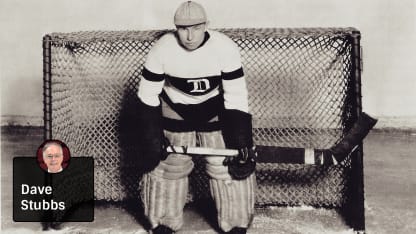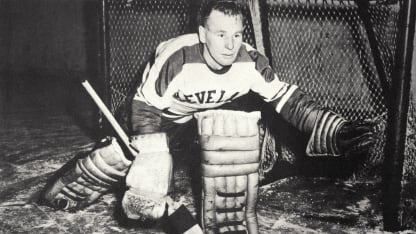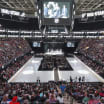Hap Holmes won four Stanley Cup championships with four teams in four leagues. Yet Holmes, one of the greatest goaltenders in the formative years of pro hockey, was overshadowed at the Hockey Hall of Fame ceremonies in Toronto 45 years ago.
Holmes, pioneering goalie, overshadowed at Hall of Fame ceremony
Inducted 45 years ago with Howe, Beliveau, Geoffrion

On the evening of Aug. 24, 1972, the focus was on three superstars for the ages -- Gordie Howe, Jean Beliveau and Bernie Geoffrion. The enshrinement of Howe and Beliveau, who each had retired following the 1970-71 season, was particularly noteworthy: This marked the first time that the customary three-year, post-retirement waiting period was waived for election to the Hall.
(That Howe would return to the game two years later for seven more seasons of pro hockey is another story, part of his remarkable lore.)
As Howe, Beliveau and Geoffrion were feted, 1972's three other inductees were almost on the undercard: Holmes, a legend during his 16-season pro career that spanned 1912-13 to 1927-28; Hooley Smith, a forward for 17 NHL seasons from 1924-25 through 1940-41 who played on two Stanley Cup champions; and builder Weston Adams, a pioneer in the Boston Bruins front office.
Each of the "other" players was welcomed to the Hall posthumously.
Smith won the Stanley Cup in 1927 with the Ottawa Senators and 1935 with the Montreal Maroons, and won a gold medal with Canada in the 1924 Chamonix Olympics. Every bit the equal of Montreal Canadiens icon Georges Vezina on most nights, Holmes won the Stanley Cup in 1914 with the National Hockey Association's Toronto Blueshirts; in 1917 with the Pacific Coast Hockey Association's Seattle Metropolitans, the first United States-based team to win the trophy; in 1918 with the Toronto Arenas, in the NHL's first season; and in 1925 with the Western Canada Hockey League's Victoria Cougars, the last non-NHL team to win the Cup.
Holmes returned to the NHL for two final pro seasons from 1926-28, with Victoria's players having been transferred to the Detroit Cougars in 1926 with the folding of the Western Hockey League (the rebranded WCHL). And the native of Aurora, Ontario, retired in a blaze of glory; he had 11 shutouts and a 1.73 goals-against average for the Cougars in 1927-28.
RELATED: [Complete NHL Centennial coverage\]
The goalie was famous for his icy demeanor and for what he wore to protect his head from objects thrown at him by fans. He even thought about using an umbrella before settling on his familiar cap.
"To the customers with a quid of tobacco, capable jaws and ordinary marksmanship, his shining bald dome presented a tempting target," Vern DeGeer of the Windsor Star wrote, as quoted in the 2002 book, "Without Fear: Hockey's 50 Greatest Goaltenders."
"I swear that one of those fellows used to load his tobacco with bird shot,' Holmes said, as quoted in the book. "After a game, my head carried so many lumps, the boys claimed I'd had an attack of chicken pox."
Holmes played senior hockey before winding up with the Blueshirts when the pro game arrived in Toronto in 1912-13, setting off on a barnstorming career.
Holmes went head-to-head against Vezina five times with the Stanley Cup or a league championship, or both, up for grabs, never losing; there was one no-decision, when the 1919 Stanley Cup Final between the Metropolitans and the Canadiens was called off midseries because of a deadly influenza epidemic.
He was far from being done with hockey when he played his final game in 1928, having played 103 NHL games (39-54-10). He'd eventually go to Cleveland, where he'd work tirelessly to help establish the Barons of the fledgling American Hockey League, for years doing everything but sell refreshments in the stands.
In declining health, Holmes moved to Florida, where he died June 27, 1941, at age 53.
In game programs for many years, the Barons paid tribute to one of their pioneers. Though Holmes never played in the AHL, the league felt his contributions to the game were worth celebrating, and introduced the Harry "Hap" Holmes Memorial Award in 1948 to recognize goaltending excellence. (Until 1971, the award went to the AHL goalie with the lowest goals-against average who appeared in at least half of his team's regular-season games. Since 1972, it has gone to the goalies who have played at least 25 games for the team with the lowest goals-against average.)
"(Holmes') nonchalance in the nets led some critics to consider him almost lazy," said Hall of Fame goalie Johnny Bower, who won the award with Cleveland three times (1952, 1957, 1958). "But easygoing doesn't mean lazy."

In the 1995 book "A Breed Apart: An Illustrated History of Goaltending," Holmes was colorfully recalled by a 1920s sportswriter for "his white pads, battered skates … horseshoes, four-leaf clovers and rabbit's feet" after he had stolen a win with his brilliance.
Thirty-one years after his death, Holmes was welcomed to the Hall of Fame. Even if he was overshadowed by Howe, Beliveau and Geoffrion, he was a most deserving addition to the shrine, a goaltending trailblazer who wore a sterling pedigree beneath a familiar cloth cap.

















